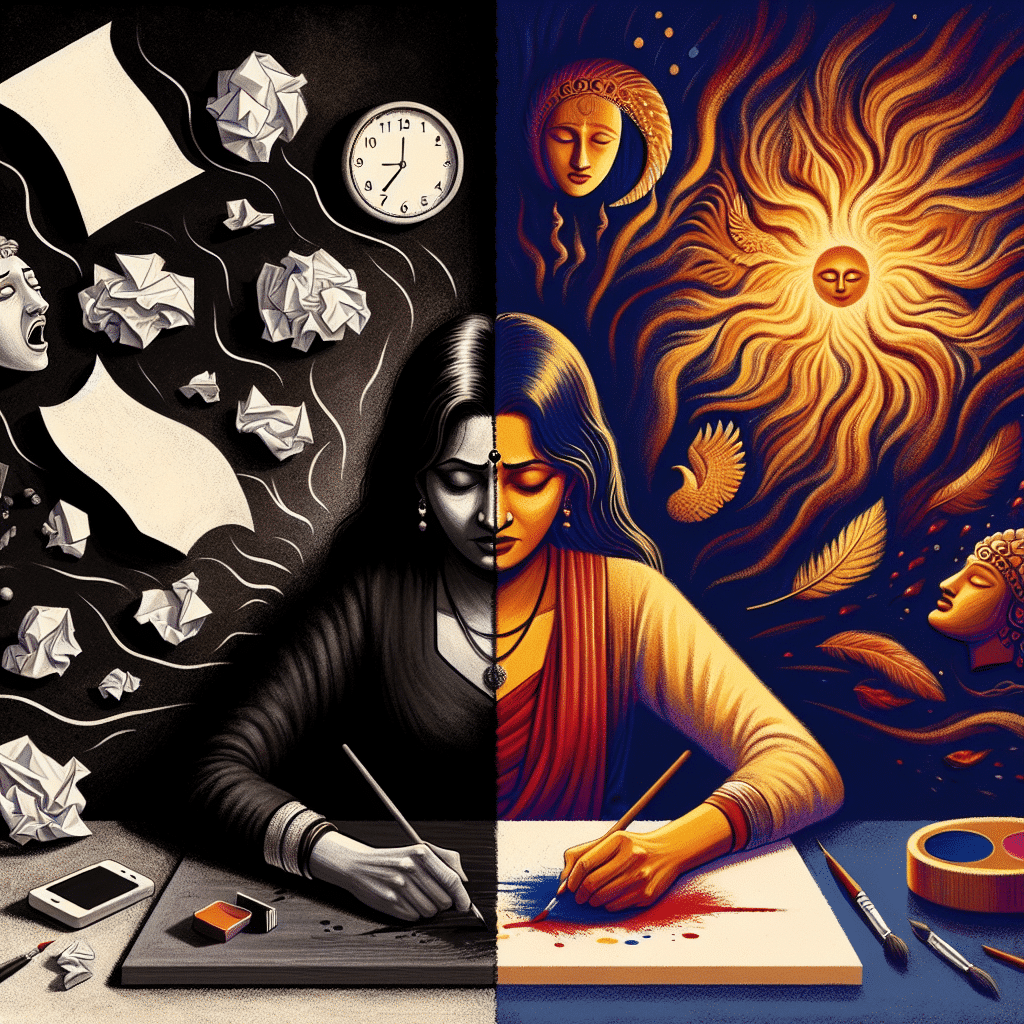
Engaging in creative activities can be a powerful tool for managing stress and promoting overall well-being. This section will explore the benefits of creativity for stress relief and provide insights on how to incorporate creative outlets into your daily routine.
Benefits of Creativity for Stress Relief
Creativity has been shown to have a multitude of benefits when it comes to stress relief. Engaging in creative activities can help to reduce cortisol levels, the hormone responsible for stress, and increase the production of endorphins, the body’s natural mood-boosting chemicals. This leads to a sense of calmness and relaxation, allowing individuals to better cope with stressors in their lives.
Moreover, creativity provides a sense of accomplishment and satisfaction, boosting self-esteem and confidence. By focusing on a creative task, individuals can temporarily escape from the pressures of everyday life and enter a state of flow, where time seems to stand still and worries fade away.
Additionally, engaging in creative pursuits can help to improve cognitive function, problem-solving skills, and emotional regulation. This can lead to better overall mental health and resilience in the face of stress.
Overall, incorporating creativity into your routine can help to reduce stress, improve mood, and enhance overall well-being. Whether it’s through painting, writing, crafting, or any other form of creative expression, finding an outlet for your creativity can be a powerful tool for stress relief.
Types of Creative Activities for Stress Relief
When it comes to using creativity as a tool for stress relief, there is no one-size-fits-all approach. Different types of creative activities work for different people, so it’s important to explore various options to find what resonates with you. Here are some popular types of creative activities that you can try:
1. Art Therapy:
Engaging in art therapy can be a powerful way to express your emotions and reduce stress. Whether it’s painting, drawing, sculpting, or even coloring, the act of creating art can be therapeutic and help you process your feelings in a visual way.
2. Writing:
Journaling, poetry, short stories, or even writing letters can be a cathartic way to channel your thoughts and emotions. Putting pen to paper allows you to unload your mind and gain a new perspective on your stressors.
3. Music:
Listening to music, playing an instrument, or even singing can all be soothing activities that help alleviate stress. Music has the power to evoke strong emotions and can serve as a form of self-expression and release.
4. Crafting:
Engaging in activities like knitting, crochet, woodworking, or other DIY projects can be a calming way to occupy your mind and hands. The process of creating something with your own two hands can be incredibly satisfying and distracting from stressors.
5. Cooking or Baking:
Experimenting in the kitchen with new recipes or baking homemade treats can be a delicious form of stress relief. The act of cooking or baking can be a mindful activity that allows you to focus on the present moment and enjoy the process.
Remember, the key is to find what activities bring you joy and allow you to express yourself freely. Don’t be afraid to try new things and see what resonates with you the most. Incorporating creativity into your routine can truly be a transformative way to manage stress and improve your overall well-being.
Tips for Incorporating Creativity into Your Routine
Introducing creativity into your daily routine can help alleviate stress and promote a sense of well-being. Here are some tips to help you incorporate creativity into your life:
1. Start Small
Don’t feel overwhelmed by the idea of being creative. Start with small, manageable tasks such as doodling in a sketchbook, writing a short story, or cooking a new recipe. These small acts of creativity can help ease stress and boost your mood.
2. Schedule Creative Time
Set aside specific blocks of time in your schedule for creative activities. Whether it’s painting, knitting, or playing a musical instrument, carving out time for creativity can help you feel more balanced and fulfilled.
3. Try New Things
Step out of your comfort zone and try new creative outlets. Experiment with different forms of art, music, dance, or writing to discover what resonates with you. Trying new things can spark inspiration and help you explore different aspects of your creativity.
4. Embrace Imperfection
Remember that creativity is about self-expression, not perfection. Allow yourself to make mistakes and embrace imperfections in your creative endeavors. Let go of self-criticism and focus on the joy of creating.
5. Collaborate with Others
Engage in collaborative creative projects with friends, family, or colleagues. Working with others can bring new perspectives and ideas to your creative process, fostering connection and shared experiences.
6. Practice Mindfulness
Stay present and mindful while engaging in creative activities. Focus on the process of creating rather than the end result. Mindfulness can help reduce stress and promote a sense of calm and relaxation.
By incorporating creativity into your routine, you can cultivate a sense of joy, inspiration, and relaxation, ultimately helping you manage stress more effectively.

Examples of Creative Outlets for Stress Relief
1. Painting or Drawing
Expressing yourself through art can be a therapeutic way to release stress and emotions. Whether you are a beginner or an experienced artist, painting or drawing allows you to focus on the present moment and channel your feelings onto a canvas or paper.
2. Crafting
Engaging in crafting activities such as knitting, crochet, or DIY projects can be a calming way to unwind and distract yourself from daily stressors. The process of creating something with your hands can provide a sense of accomplishment and boost your mood.
3. Writing
Writing can be a powerful tool for processing your thoughts and emotions. Whether you choose to journal, write poetry, or start a blog, putting your feelings into words can help you gain clarity and perspective on your stressors.
4. Music
Listening to music or playing an instrument can have a soothing effect on your mind and body. Music has the power to evoke emotions and can help you relax and unwind after a long day. Consider creating a playlist of your favorite songs or learning to play a new instrument for stress relief.
5. Gardening
Spending time in nature and tending to a garden can be a peaceful way to connect with the earth and reduce stress. Planting flowers, vegetables, or herbs can provide a sense of accomplishment and allow you to take a break from everyday worries.
6. Dance
Moving your body to the rhythm of music can be a fun and energizing way to relieve stress. Dancing not only helps release endorphins but also allows you to express yourself through movement and connect with your body.
By incorporating these creative outlets into your routine, you can discover new ways to manage and reduce stress in your life. Experiment with different activities and find what works best for you in promoting relaxation and well-being.
Examples of Creative Outlets for Stress Relief
There are countless creative outlets that can help individuals alleviate stress and improve their overall well-being. Here are some examples of creative activities you can try:
1. Painting or Drawing
Engaging in visual arts like painting or drawing can be a therapeutic way to express emotions and relieve stress. You don’t need to be a professional artist to enjoy the benefits of putting pen to paper or brush to canvas.
2. Writing or Journaling
Writing can be a powerful tool for processing emotions and thoughts. Keeping a journal, writing poetry, or starting a short story can provide an outlet for self-expression and introspection.
3. Crafting or DIY Projects
Creating something with your hands, whether it’s knitting, woodworking, or making home decor, can be a rewarding way to relax and unwind. Engaging in DIY projects allows you to focus on the process and enjoy the satisfaction of completing something tangible.
4. Music or Dance
Listening to music, playing an instrument, or dancing can all be excellent ways to release pent-up stress and boost your mood. Music has the power to evoke emotions and create a sense of connection, making it a valuable tool for stress relief.
5. Cooking or Baking
Cooking or baking can be a creative and therapeutic way to nourish your body and soul. Trying out new recipes, experimenting with flavors, and sharing your culinary creations with loved ones can bring joy and relaxation.
6. Gardening or Nature Art
Spending time in nature, tending to a garden, or creating art inspired by the natural world can have a calming effect on the mind and body. Connecting with the outdoors and engaging in nature-based activities can reduce stress and improve overall well-being.
By incorporating these creative outlets into your routine, you can discover new ways to manage stress, express yourself, and cultivate a sense of accomplishment. Embrace the power of creativity as a tool for stress relief and self-care.

Conclusion: Embrace Creativity for Stress Relief
Embracing creativity as a tool for stress relief can have numerous benefits for our mental health and overall well-being. Engaging in creative activities can help us to relax, unwind, and express ourselves in ways that words alone cannot convey.
From painting and writing to dancing and crafting, there are countless ways to incorporate creativity into our daily routines. By making time for these activities, we can actively manage and reduce our stress levels, leading to a happier and healthier life.
So, whether it’s picking up a pen, a paintbrush, or a musical instrument, don’t hesitate to unleash your creativity and experience the soothing effects it can have on your mind and body ー your well-being will thank you for it.






